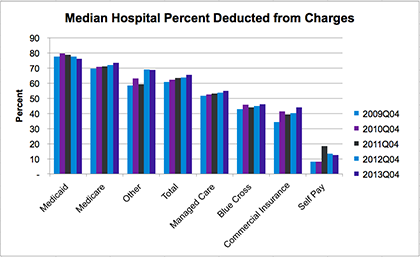Joint Replacement in Ada, OK: $5,300. Same Procedure in Monterey Park, CA: $223,000
By:
When it comes to healthcare, America ranks dead last among industrialized nations in affordability and patient access. And while the Affordable Care Act (aka: Obamacare) has made strides in reducing the number of Americans who are uninsured, healthcare costs are expected to grow another 6.8% in 2015 due to an influx of new patients covered (many of whom have delayed procedures and check-ups because times were tough). A Commonwealth Fund survey found that Americans on average spend $4,000 more in healthcare costs than their European counterparts. What's worse-- the exorbitant price of medication has discouraged 40% of Americans from filling their prescriptions. How is this happening?
One particular problem in the system is the variation in pricing for procedures from one hospital to the next. In light of this issue, many have began to investigate the role and efficacy of the chargemaster, or the "lengthy list of a hospital's prices for every single procedure performed in the hospital and for every supply item used during those procedures." If the hospital is a restaurant, think of the chargemaster as the really long menu.
Currently, the same procedure may differ egregiously from one part of the country to the next. In Ada, Oklahama a joint replacement surgery costs around $5,300 but in Monterey Park, California the same procedure costs upwards of $223,000. But this inconsistency is not solely a result of geographic factors. Even within the city of Denver, treatment for heart failure ranges from $21,000 to $46,000. It is clear we need a more streamlined system.
In reality, the prices listed on the chargemaster are not altogether relevant. Medicare uses information from hospital expense reports to calculate how much a procedure actually costs. In a report released by the Centers for Medicare and Medicaid Services (CMS) the average chargemaster bill amounted to $32,963. Medicare paid an average of $5,700. Likewise, Insurance companies receive large discounts or negotiate down from the chargemaster prices. The only people paying full sticker price for medical care are those that are not insured, which constitute a very small percentage of unfortunate patients. What purpose then, does the chargemaster serve?

What we need, first and foremost, is more transparency. We should know how much a procedure actually costs-- not the bloated, irrelevant figures currently represented by our country's chargemasters. We should also know how much different insurance companies pay for specific procedures at individual hospitals. That kind of information will help patients make educated decisions about healthcare.Yes, healthcare does not always operate in a free market (ie: if you break a bone and are in a ton of pain, you don't get the opportunity to shop around for hospitals), but healthcare should not mirror the experience of going to a sly mechanic and not knowing if you're being swindled.
In the state of Maryland, the hospital payment system establishes a fixed schedule of payments to all hospitals by all payers. Each hospital receives the same amount for the same services and supplies, so there is no incentive for hospitals to charge an amount greater than that what they expect to be paid. These principles of transparency can help end culture of undisclosed costs in our country.
To learn more about why healthcare in America is so expensive, watch this video:
